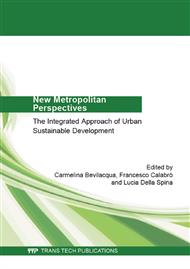[1]
J. Ahern: Greenways as a planning strategy, in Landscape Urban Planning, vol. 33, no. 1, p.131–155, (1995).
DOI: 10.1016/0169-2046(95)02039-v
Google Scholar
[2]
R. Ryan, J. G. Fábos, A. Csemez, J. Machado, and A. Toccolini: Balancing culture and nature through greenway planning, in American Society of Landscape Architects Annual Meeting Proceedings September 21-25, (2001), pp.118-121.
Google Scholar
[3]
J. G. Fábos and R. L. Ryan: International greenway planning: an introduction, Landsc. Urban Plan., vol. 68, no. 2, (2004), pp.143-146.
DOI: 10.1016/s0169-2046(03)00155-5
Google Scholar
[4]
R. H. G. Jongman and G. Pungetti, Eds.: Ecological networks and greenways: concept, design, implementation. Cambridge University Press, (2004).
DOI: 10.1017/cbo9780511606762.003
Google Scholar
[5]
C. E. Little: Greenways for America. John Hopkins University Press (1995).
Google Scholar
[6]
G. Senes: Il censimento delle linee dismesse in Italia, in: Ferrovie, territorio e sistema di greenways, (2004), pp.100-107.
Google Scholar
[7]
M. Angrilli: Greenways, in: Urbanistica, vol. 51, no. 113, (1999), pp.92-97.
Google Scholar
[8]
S. Oppido: Renewal and enhancement of natural and built heritage in rural areas: a greenways network for a sustainable management strategy, in: Proceedings of Heritage 2010. 2nd International Conference on Heritage and Sustainable Development. Évora, Portugal, June 22-26, 2010, (2010).
DOI: 10.1017/s0940739110000421
Google Scholar
[9]
S. B. Pena, M. M. Abreu, R. Teles, and M. D. Espírito-Santo: A methodology for creating greenways through multidisciplinary sustainable landscape planning, in: J. Environ. Manage., vol. 91, no. 4, (2010), pp.970-983.
DOI: 10.1016/j.jenvman.2009.12.004
Google Scholar
[10]
J. Ahern: Greenways in the USA: theory, trends and prospects, in: Ecological Networks and Greenways. Concept, Design, Implementation, R. H. G. Jongman and G. Pungetti, Eds. Cambridge: Cambridge University Press, (2004), pp.34-55.
DOI: 10.1017/cbo9780511606762.005
Google Scholar
[11]
V. G. G. Mennella: Greenway per lo sviluppo sostenibile del territorio. Milano: Il Verde Editoriale (2004).
Google Scholar
[12]
J. G. Fabos and J. F. Ahern: Greenways: the beginning of an international movement. Amsterdam: Elsevier Amsterdam, The Netherlands (1995).
Google Scholar
[13]
Information on http: /www. aevv-egwa. org.
Google Scholar
[14]
EGWA, E. Commission, and D. Environment: The European Greenways Good Practice Guide: Example of Action Undertaken in cities and in the Periphery. (2002).
Google Scholar
[15]
EGWA: Greenways provide the answer to preserving Europe's railway heritage. European Greenways Info (2012).
Google Scholar
[16]
C. Aycart: Il progetto spagnolo per le Vias Verdes, in: Ferrovie, territorio e sistema di greenways, (2004), pp.108-113.
Google Scholar
[17]
L. Centeno: Il progetto portoghese di Ecopistas, in: Ferrovie, territorio e sistema di greenways, (2004), pp.116-121.
Google Scholar
[18]
RFI and ISFORT, No Title, in: Ferrovie, territorio e sistema di greenways, (2004).
Google Scholar
[19]
G. Senes, N. Fumagalli, and R. Rovelli: Le greenways come rete di mobilità alternativa. Il recupero dei sedimi ferroviari dismessi come greenways: sintesi di una ricerca, (2004), pp.44-88.
Google Scholar
[20]
F. Torella, No Title, in: V European Greenways Conference, (2010).
Google Scholar
[21]
P. Dal Sasso and M. A. Ottolino, GREENWAY IN ITALY: EXAMPLES OF PROJECTS AND IMPLEMENTATION, in: J. Agric. Eng., vol. 42, no. 1, (2011), pp.29-40.
DOI: 10.4081/jae.2011.39
Google Scholar
[22]
Information on http: /www. greenwayseurope. org.
Google Scholar
[23]
Information on"http: /www. fsitaliane. it.
Google Scholar
[24]
Information on http: /www. ferrovieabbandonate. it.
Google Scholar
[25]
Information on http: /www. ferroviedimenticate. it.
Google Scholar
[26]
M. R. Pinto: Strategie di riuso per la valorizzazione del costruito, in: Nuovi usi per la tutela e la valorizzazione del patrimonio costruito. La privatizzazione dei beni immobili pubblici, 2010), pp.162-167.
DOI: 10.3280/crios2018-016003
Google Scholar
[27]
R. K. Yin, Case study research: Design and methods, vol. 5. Londra: Sage, (2009).
Google Scholar
[28]
Information on http: /www. vesuviopark. it.
Google Scholar


